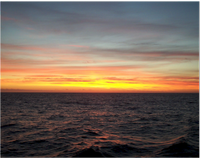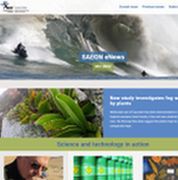SAEON Nodes
 The
SAEON Arid Lands Node conducts observations on the ecological effects of Global
Change and Land Use Changes across the hyper-arid to semi-arid western half of
South Africa, where mean annual precipitation is 45-450 mm, and potential
evapotranspiration exceeds precipitation 5-50 fold. The area
stretches between latitude 25-33oS and longitude 16.5-26oE across 500,000 km2,
encompassing the Northern Cape and parts of the North-West-, Free State-,
Eastern Cape- and Western Cape provinces. Visit the webpage here.
The
SAEON Arid Lands Node conducts observations on the ecological effects of Global
Change and Land Use Changes across the hyper-arid to semi-arid western half of
South Africa, where mean annual precipitation is 45-450 mm, and potential
evapotranspiration exceeds precipitation 5-50 fold. The area
stretches between latitude 25-33oS and longitude 16.5-26oE across 500,000 km2,
encompassing the Northern Cape and parts of the North-West-, Free State-,
Eastern Cape- and Western Cape provinces. Visit the webpage here.
 Egagasini
Node for marine-offshore systems is an observation site of SAEON that is hosted
by the new Oceans and Coasts branch of the Department of Environmental Affairs
(DEA), and also works closely with the Fisheries Branch of Department of
Agriculture Forestry and Fisheries (DAFF). The node works with a wide range of
partners to combine data, resources and knowledge of the oceans surrounding
South Africa, their ecosystems and biodiversity to comprehend and fully
appreciate their role in climate change as well as the impact of climate change
on the oceans’ resources. Visit the webpage here.
Egagasini
Node for marine-offshore systems is an observation site of SAEON that is hosted
by the new Oceans and Coasts branch of the Department of Environmental Affairs
(DEA), and also works closely with the Fisheries Branch of Department of
Agriculture Forestry and Fisheries (DAFF). The node works with a wide range of
partners to combine data, resources and knowledge of the oceans surrounding
South Africa, their ecosystems and biodiversity to comprehend and fully
appreciate their role in climate change as well as the impact of climate change
on the oceans’ resources. Visit the webpage here.
 The SAEON Elwandle Coastal Node is based in Port Elizabeth. It forms one of six nodes
of the SAEON network, which is part of the National Research Foundation. The
Elwandle Coastal Node is mandated to undertake long-term monitoring and
research on South Africa’s coastal zone. The node is comprised of a dynamic
team of driven individuals who are tirelessly striving to detect, understand
and predict environmental change in South Africa's coastal ecosystems. Visit the webpage here.
The SAEON Elwandle Coastal Node is based in Port Elizabeth. It forms one of six nodes
of the SAEON network, which is part of the National Research Foundation. The
Elwandle Coastal Node is mandated to undertake long-term monitoring and
research on South Africa’s coastal zone. The node is comprised of a dynamic
team of driven individuals who are tirelessly striving to detect, understand
and predict environmental change in South Africa's coastal ecosystems. Visit the webpage here.
 The SAEON Fynbos Node forms
part of the South African Environmental Observation Network (SAEON), a business
unit within the National Research Foundation. The Department of Science
and Technology established SAEON as an institute to conduct long term
environmental observation and promote an informed and timely response to global
change. SAEON is an institution with a country wide
presence that encompasses the major terrestrial, coastal and oceanic
environments. We aim to understand the
impacts of global change in Fynbos and how this will affect us by answering
these questions: How
does fynbos work? How are we changing fynbos and what it does for us? Visit the webpage here.
The SAEON Fynbos Node forms
part of the South African Environmental Observation Network (SAEON), a business
unit within the National Research Foundation. The Department of Science
and Technology established SAEON as an institute to conduct long term
environmental observation and promote an informed and timely response to global
change. SAEON is an institution with a country wide
presence that encompasses the major terrestrial, coastal and oceanic
environments. We aim to understand the
impacts of global change in Fynbos and how this will affect us by answering
these questions: How
does fynbos work? How are we changing fynbos and what it does for us? Visit the webpage here.
Grasslands, Forests, and Wetlands Node
 The SAEON Grasslands-Forests-Wetlands node
role is to conduct in situ monitoring to detect human induced global change and
understand mechanisms and processes allied to these changes in these biomes and
within South Africa. The intention is that this information will provide
insight that will improve our understanding of anthropogenic forcing and what
this means for society. Visit the webpage here.
The SAEON Grasslands-Forests-Wetlands node
role is to conduct in situ monitoring to detect human induced global change and
understand mechanisms and processes allied to these changes in these biomes and
within South Africa. The intention is that this information will provide
insight that will improve our understanding of anthropogenic forcing and what
this means for society. Visit the webpage here.
The Ndlovu Node is a branch of SAEON that focuses on understanding environmental change occurring in the savanna biome of South Africa. Based in the Kruger National Park, at Phalaborwa, the Node runs a number of long-term research projects in the north-eastern part of the country, in national parks, private conservation areas, mining areas and rural rangelands. “Ndlovu”, the name chosen for the Node, means “elephant” in isiZulu. It symbolizes the relatively pristine state of many ecosystems in the savanna biome, as well as the role that these ecosystems play in sustaining economic activities and the livelihoods of people living in the region. Visit the webpage here.
SAEON uLwazi Node

SAEON uLwazi node is the central unit with the focus of supporting SAEON and the stakeholders in the environmental and SET field with data products and systems.
uLwazi is uniquely positioned within SAEON to assist South Africa to effectively respond to long-term global change. The integration and publishing of data products and systems in an understandable and accessible manner will facilitate the decision-making process and allow for a defensible response to a range of social, economic and environmental drivers. Visit the website here.











